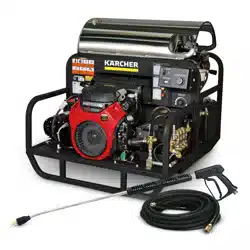Loading ...
Loading ...
Loading ...

19
Maintenance
Cleaning of Coils:
In alkaline water areas, lime deposits can accumulate
rapidly inside the heating coil. This growth is increased
by the extreme heat build up in the coil. The best
preventative for liming conditions is to use high quality
cleaning detergents. In areas where alkaline water is
an extreme problem, periodic use of Coil Conditioner
will remove lime and other deposits before coil
becomes plugged. (See Deliming instructions for use of
Coil Conditioner.)
Deliming Coils:
Periodic flushing of coils or optional float tank is recom-
mended.
1. Fill a container with 4 gallons of water, then add 1
lb. of deliming powder. Mix thoroughly. Pour
mixture into float tank.
2. Remove wand assembly from spray gun and put
spray gun into float tank. Secure the trigger on the
spray gun into the open position.
3. Turn engine on, allowing solution to be pumped
through coils back into the float tank. The solution
should be allowed to circulate 2- 4 hours or until
the color changes.
4. After circulating solution, flush the entire system
with fresh water. Clean out float tank and then
reinstall wand assembly to spray gun.
Removal of Soot from Heating Coil:
In the heating process, fuel residue in the form of soot
deposits may develop between the heating coil pipe,
and block air flow which will affect burner combustion.
When soot has been detected on visual observation,
the soot on the coil must be washed off after following
the coil removal steps (See Coil Removal section).
Fuel:
Use clean fuel oil that is not contaminated with water
and debris. Replace fuel filter and drain tank every 100
hours of operation.
Use No.1 or No 2 Heating Oil (ASTM D306) only.
NEVER use gasoline in your burner fuel tank. Gasoline
is more combustible than fuel oil and could result in a
serious explosion. NEVER use crankcase or waste oil
in your burner. Fuel unit malfunction could result from
contamination.
Fuel Control System:
This machine utilizes a fuel solenoid valve located on
the fuel pump to control the flow of fuel to the combus-
tion chamber. The solenoid, which is normally closed, is
activated by a flow switch when water flows through it.
When the operator releases the trigger on the spray
gun, the flow of water through the flow switch stops,
turning off the electrical current to the fuel solenoid.
The solenoid then closes, shutting off the supply of fuel
to the combustion chamber. Controlling the flow of fuel
in this way gives an instantaneous burn-or-no-burn situ-
ation, thereby eliminating high and low water tempera-
tures and the combustion smoke normally associated
with machines incorporating a spray gun. Periodic
inspection, to insure that the fuel solenoid valve
functions properly, is recommended. This can be done
by operating the machine and checking to see that the
burner is not firing when the spray gun is in the OFF
position.
Rupture Disk:
If pressure from pump or thermal expansion should
exceed safe limits, the rupture disk will burst allowing
high pressure to be discharged through hose to ground.
When disk ruptures it will need to be replaced.
The Rupture Disk should be replaced every two years.
Kärcher SSG Operator’s Manual 9.801-193.0 - BF
Loading ...
Loading ...
Loading ...
